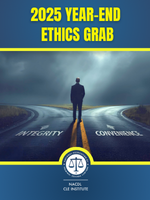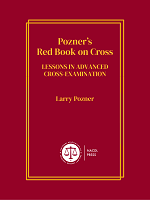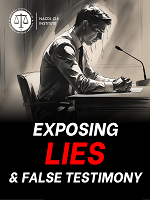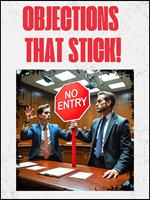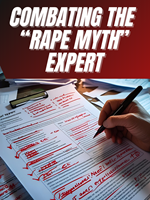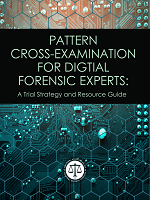Access to The Champion archive is one of many exclusive member benefits. It’s normally restricted to just NACDL members. However, this content, and others like it, is available to everyone in order to educate the public on why criminal justice reform is a necessity.
There is a very simple proposal that, if adopted tomorrow by every state and federal judge, would solve many of the vexing problems that have hamstrung meaningful compliance with Brady v. Maryland over the last 50 years. It relies on state law, but it would bind every state and federal prosecutor who wants to keep a license to practice law. It is called the “ethical rule” order — an Occam’s razor for the disclosure of exculpatory evidence. All players in the criminal justice system should support it. Every defense lawyer should request it as an essential aspect of effective advocacy. Judges who honor the profession’s ethical rules will grant it and even wonder why no one has asked them to do so before.1 Ethical prosecutors should be receptive because it provides clarity to a disclosure obligation that has remained unnecessarily murky for decades. And, finally, it will work because a violation of an “ethical rule” order by individual prosecutors, acting deliberately and in bad faith, will carry serious personal consequences.
Model Rule 3.8(d)
Forty-nine states, Guam, the U.S. Virgin Islands, and the District of Columbia have adopted a version of ABA Model Rules of Professional Conduct Rule 3.8-Special Responsibilities of a Prosecutor (Rule 3.8).2 The rule requires prosecutors to disclose pretrial all evidence that “tends to negate the guilt of the accused or mitigates the offense.”3 The ABA has made it plain that this disclosure obligation is “separate from and broader than the Brady constitutional standards.”4 Viewed from a pretrial perspective, the Brady constitutional standard covers (a) material that a prosecutor knows or should know about (including information in law enforcement files that the prosecutor does not personally possess),5 and (b) comprising information that an appellate court, postconviction, would regard as so important (“material”) the failure to disclose it requires a reversal and a new trial.6 Plainly, as many have observed, this “constitutional” obligation is not particularly helpful to anyone trying to comply pretrial — be it the prosecutor wondering whether information is Brady material, the defense counsel, or the court. It was for this very reason the ABA devised Rule 3.8 to be unambiguously broad: Rule 3.8 requires a prosecutor to “make timely disclosure to the defense of all evidence or information known to the prosecutor that tends to negate the guilt of the accused or mitigates the offense, and, in connection with sentencing, [to] disclose to the defense and to the tribunal all unprivileged mitigating information known to the prosecutor.”7 At the same time, it provides an escape clause for in camera production when timely disclosure could endanger a witness or otherwise unfairly prejudice the prosecution before trial.8
What the defense attorney should do to make the “ethical order” motion is very straightforward: File a pretrial motion that tracks and cites the relevant ethical rule of the defense attorney’s jurisdiction or in the case of federal prosecutors, the rule that applies to the state where that prosecutor is based and/or governs the federal proceeding. Ask for an order that the prosecutor search her file and disclose all information that “tends to negate the guilt of the accused or mitigates the offense.” Be specific. Lay out, within the bounds of what makes sense strategically, the defense theory of the case and the kind of information that would tend to negate guilt. Identify the files of the agencies and investigators who were involved in gathering evidence for the prosecution, and request that the prosecutor search those files and verify that disclosure has been made of all information that tends to negate guilt or mitigate punishment. Be sure to request that the prosecutor disclose on the record or reduce to writing all favorable oral statements she discovers when interviewing witnesses.
Address the timeliness issue directly. If there is some special reason a certain type of favorable information should be disclosed more rapidly, say so. Include, because it is reasonable, appropriate, and will be appreciated by the court and the prosecutor, the safe harbor provision in the ethical rule that allows the prosecutor to delay disclosure by making an in camera ex parte production and a showing of “good cause,” such as real evidence that witnesses are at risk or perjury will be suborned. Moreover, when the prosecutor is not sure that certain information tends to negate guilt or mitigate punishment, the order should provide for in camera ex parte production of that information.
The defense attorney should be aware as well of a strategic landmine on the timing question: if the defense lawyer claims she is entitled to early disclosure of all impeachment material under the ethical rule because it could “negate guilt,” particularly prior statements of witnesses that many state statutes and federal law explicitly allow a prosecutor to withhold until the time the witness testifies, the defense attorney will unnecessarily muddy her own argument that the “timely” disclosure requirement of the ethical rule entitles the defense to disclosure of favorable evidence before the eve of trial. Where there is no clear statutory basis for the state to withhold favorable evidence until the eve of trial, an ethical rule order requiring earlier production of favorable evidence is more likely to be granted and upheld if, by some mechanism, the prosecutor manages to get an interlocutory appeal.9 Similarly, trying to enforce disclosure of merely “favorable” evidence pursuant to an ethical rule order very early in the proceedings, and just prior to an early guilty plea, is bound to be more difficult given United States v. Ruiz.10 The earlier the defense seeks a search and disclosure of prosecutor and police files pursuant to an ethical rule order, the more likely objections that doing so is too burdensome will be upheld.
Finally, the motion should ask for an order that clearly states that “willful and deliberate failure to comply” is punishable by contempt. This provision is very important and carefully worded. Yes, this means that negligent, inexperienced, stupid, even reckless prosecutors will not be held in contempt. But frankly, given the mens rea requirements in most jurisdictions and the realities of criminal practice, the only prosecutors who will be held in contempt for violating the ethical rule order are those who do so willfully and deliberately. Perhaps most important of all — based on discussions with leaders in the prosecutorial community and the judiciary — there is widespread agreement that the handful of prosecutors who deliberately and willfully suppress favorable evidence, even in “harmless error” cases, should be sanctioned for purposes of deterrence alone. And it is the repeat offender — the prosecutor who routinely makes untimely disclosure of Brady material in the middle of trial or is caught more than once hiding evidence that is plainly exculpatory — who is most at risk of being sanctioned. After all, prior similar acts are a pretty good way to prove intent!
Judges and prosecutors may be startled initially when they see the “ethical rule” motion as opposed to the usual request to turn over all Brady/Kyles material. But upon reflection, what can a prosecutor credibly say in opposition? That the state does not recognize the ethical rule, invariably a state statutory obligation, as binding? That the state does not believe it is right or fair to be ordered to obey an ethical rule that is clear and broad as opposed to the “constitutional” obligation that is ambiguous and narrow? Or, that the state does not want to be ordered to follow the ethical rule because a violation later deemed to be knowing, deliberate, and malicious could result in a contempt proceeding, civil or criminal, and possibly bar discipline? Just stating these arguments reveals their bankruptcy and the value of the “ethical rule” order.
Perhaps a more sophisticated and polite response from prosecutors to an “ethical rule” motion would be the usual: “Trust us.” They might say, “When following our constitutional obligation to turn over all Brady/Kyles material, the state will meet its ethical obligation to disclose all information that ‘negates guilt or mitigates punishment.’” What would be the defense attorney’s polite response? “With all due respect, your answer concedes the ethical rule should be followed. An order mandating that the ethical rule be enforced is not an accusation, but is a principled position to address what we now know to have happened too often.” Brady/Kyles violations do happen; scores of innocent people have been convicted by those violations. Indeed, such an order will bolster public confidence in the integrity of the process in the face of media exposés about federal and state prosecutors who have violated their disclosure obligations. Numerous articles, which can be appended to the motion for an ethical rule order, have highlighted the Brady abuses. A list of those articles is available on NACDL’s website.11 The defense attorney will have to make a strategic judgment about the wisdom of including anything from her own jurisdiction. Sometimes it is easier to persuade a judge to act prophylactically when the court’s action is not predicated on abuses or alleged abuses by people she knows but as a response to the public relations problem created by a few bad apples elsewhere.
Morton and Stevens
Why will this work when other approaches have not?12 The answer comes from two high profile Brady cases with totally different outcomes — the Michael Morton exoneration in Texas and the collapse of the prosecution of Sen. Ted Stevens in Washington, D.C.
Former Sen. Ted Stevens of Alaska was indicted and found guilty of receiving benefits and other things of value from VECO Corporation, Bill Allen, the VECO CEO, and two other individuals; concealing receipt of such benefits; and failing to disclose receipt of such benefits on annual Financial Disclosure Forms.13 The Department of Justice (DOJ) moved to set aside the verdict and to dismiss the indictment with prejudice when DOJ attorneys discovered during post-trial litigation “significant, undisclosed Brady/Giglio information in prosecutors’ notes of statements by the government’s principal witness, Bill Allen.”14 U.S. District Judge Emmet G. Sullivan granted the DOJ’s motion and dismissed the indictment with prejudice and, on the same day, appointed Henry F. Schuelke III “to investigate and prosecute such criminal contempt proceedings as may be appropriate” against the six prosecutors who conducted the investigation and trial of Sen. Stevens.15 Schuelke found “evidence that compels the conclusion, and would prove beyond a reasonable doubt,” that Joseph Bottini and James Goeke, both AUSAs in the Alaska U.S. Attorney’s Office, “intentionally withheld … Brady information from the attorneys for Sen. Stevens.”16 However, Schuelke did not recommend prosecution of Bottini and Goeke for criminal contempt:
Although the evidence establishes that this misconduct was intentional, the evidence is insufficient to establish beyond a reasonable doubt that Mr. Bottini and Mr. Goeke violated the criminal contempt statute, 18 U.S.C. § 401, which requires the intentional violation of a clear and unambiguous order. Although a reading of the transcripts of numerous hearings and proceedings before and during the trial establishes that Judge Sullivan intended that all Brady and Giglio material be produced, none of the orders issued by Judge Sullivan, before or during the trial, specifically directed the prosecutors to disclose all Brady/Giglio information in their possession. In large part, this was because of representations made by prosecutors to the court that such an order was unnecessary.17
When the issue was raised, Judge Sullivan indicated that he would just “issue an order as a general reminder to the government of its daily ongoing obligation to produce [Brady] material” and stated that he was “convinced that the government in its team of prosecutors is thoroughly familiar with the decisions from our circuit and from my colleagues on this court, and that they, in good faith, know that they have an obligation, on an ongoing basis to provide the relevant, appropriate information to defense counsel to be utilized in a usable format as that information becomes known or in possession of the government.”18
In stark contrast to the Stevens’ case, Michael Morton’s 1987 wrongful conviction for murdering his wife also involved numerous Brady violations, but it was preceded by a specific motion and direct court order to turn over all reports and notes of the lead investigator, Sgt. Don Wood, for in camera Brady review.19 Ken Anderson, at that time the Williamson County district attorney and now a Williamson County Superior Court judge, was asked point blank by the trial court, on a Friday before a Monday trial, if he had “any information favorable to the accused.” He replied, “No, sir.”
In fact, more than two decades after the trial, when postconviction DNA tests on a bloody bandana left near the point of exit exonerated Morton and identified the real perpetrator, undisclosed exculpatory evidence was discovered in Sgt. Wood’s files through an open record act request. These exculpatory documents included a transcript of a taped interview between Wood and Morton’s mother-in-law, Rita Kirkpatrick, in which she described Morton’s son Eric, 3½ years old, saying he had witnessed the murder. Eric provided a detailed, chilling account of how a “monster” with “red gloves” beat his mother, and Eric offered a number of detailed observations that precisely corroborate the crime scene and the manner of the victim’s death. When Kirkpatrick advised Sgt. Wood to stop looking at her son-in-law as the murderer and to go after the “monster,” Sgt. Wood speculated that Eric had not recognized his own father because Morton had probably been wearing a scuba diving suit as a disguise. He then asked Kirkpatrick to keep what she had heard confidential. There was also a report recounting statements made by a neighbor of the Mortons right after the murder. The neighbor had observed on several occasions “a male park a green van on the street behind [the Mortons] address, then the subject would get out and walk into the wooded area off the road” as if he were casing the place for a home invasion. This “green van” report clearly supported Morton’s theory of defense that someone had entered the house to commit a burglary from the wooded area after Morton left for work, found Christine Morton sleeping, and murdered her.20
Notwithstanding the order for in camera Brady inspection of Sgt. Wood’s file and a direct inquiry by the court about the existence of exculpatory evidence, neither the “Kirkpatrick” statement or the “green van” report were submitted to the trial judge or disclosed to defense counsel, even though versions of those documents were in both Sgt. Wood’s file and Anderson’s trial file.
Taking advantage of an unusual Texas procedure, the Court of Inquiry,21 Morton’s defense team22 produced sworn testimony and evidence obtained in Morton’s postconviction habeas proceeding to make a probable cause showing that Ken Anderson had violated the laws of Texas by suppressing exculpatory evidence in the Morton prosecution. Judge Sid Harle from San Antonio was appointed by the chief judge of the Texas Supreme Court, Wallace Jefferson, to hear the Morton case after the administrative judge in Williamson County recused himself. Judge Harle then made the first probable cause finding under the Court of Inquiry procedure, which was then accepted by the chief judge, who in turn appointed Fort Worth Judge Lewis Sturm to review the evidence and determine whether Judge Anderson should be arrested and tried. Judge Sturm selected Rusty Hardin, a legendary criminal defense lawyer and former Harris County prosecutor, to serve as attorney pro tem.
After a five-day evidentiary hearing, on April 19, 2013, 27 years after Morton was convicted, Judge Ken Anderson was arrested in the Williamson County Courthouse and charged with Criminal Contempt, Texas Government Code § 21.002(a), Tampering With or Fabricating Physical Evidence, Texas Penal Code § 37.09; and Tampering With Government Records, Texas Penal Code § 37.10. It should be noted that Anderson may have some success raising the statute of limitations as an affirmative defense to the tampering charges, but that defense is unlikely to defeat the Criminal Contempt allegation. There may not even be a statute of limitations in Texas for Criminal Contempt, or if there is one, it runs from the time of discovery. Anderson is also facing state bar ethics charges arising out of the same conduct.
Whatever the outcome of criminal or state bar charges against Judge Anderson, the impact of the Morton Court of Inquiry in Texas has been significant. John Bradley, Ken Anderson’s protégé and successor as Williamson County district attorney, was not re-elected. The Republican-controlled Texas Legislature passed the “Michael Morton” discovery reform bill on May 13, 2013 — the very date Brady was decided 50 years ago — with support from the District Attorney’s Association and the Texas Criminal Defense Lawyers Association. The Morton bill expands discovery disclosure generally but, most importantly, it adopts the ethical rule standard — prosecutors must timely disclose all information that “tends to negate guilt or mitigate punishment” — an obligation that can easily be converted into an “ethical rule order” by state trial judges.23 Another bill, the Prosecutor Accountability Act, passed on account of the Morton case. It requires at least a public censure if a prosecutor violates the ethics rule requiring disclosure of exculpatory evidence.24 And many district attorneys in Texas are instituting “open-file” discovery policies, claiming it is the best way to avoid Brady problems and to reassure the public they are playing fair. The take home message is that simply exposing a “bad apple” prosecutor for willful and deliberate misconduct is not enough; rather, a serious and rapid sanction for even one “bad apple” is what gets the criminal justice community and the political elites to pay attention.
In the same fashion, the ethical rule order will both generally and specifically deter “bad apple” prosecutors because it is not subject to many of the practical and procedural hurdles that have obstructed punishment even for deliberate, intentional, and malicious Brady violations.
Ordinarily the remedy for a Brady violation is the reversal of the conviction because the suppressed exculpatory evidence was “material.” After looking at the record, an appellate court would decide that the suppressed evidence created a reasonable probability of a different outcome such that confidence in the integrity of the verdict was undermined. While Brady was not about deterring future violations (rather than preserving the due process right to a fair trial and accuracy in adjudication25), some believe that district attorneys, embarrassed when a conviction is reversed for withholding exculpatory evidence, will take ameliorative steps. They will punish the individual prosecutor who was a bad actor or, when no one was at fault, fix the systemic breakdown that caused the failure to disclose in the first place. Indeed, the Supreme Court relied on this justification in Imbler v. Pachtman when it established absolute immunity for prosecutors from civil suits, insofar as the prosecutor is functioning in an adversarial, not investigative, capacity.26 In a recent brief to the Supreme Court, urging the further narrowing of liability under 42 U.S.C. § 1983 for prosecutorial misconduct, the National District Attorney’s Association and the Association of State Attorney’s General underscored the deterrent value of the very threat of bar discipline, criminal prosecution, and political embarrassment.27
But even if some district attorneys are taking such action when convictions are vacated, this approach does nothing to identify district attorneys or individual prosecutors who deliberately suppress exculpatory evidence in “harmless error” cases. Cases involving obviously guilty defendants are not likely to engender much public outrage or impetus for action. Those prosecutors will escape public scrutiny and surely, public punishment. In contrast, the ethical rule order offers a remedy through which the defense bar can take direct action against individual prosecutors who deserve to be sanctioned in front of the judge whose order was violated.
Like the Morton case, and unlike the Stevens matter, violations of an ethical rule order are more likely to result in contempt citations, bar discipline, or even criminal prosecution. It allows the judge who issued the order to enforce it directly through a contempt citation without having to wait for the prosecutor’s office to take action against one of its own. At the same time, since contempt has to be knowing and deliberate, inexperienced, negligent, or ill-trained prosecutors will not be sanctioned, thereby assuring the legal community this remedy is reserved for those who truly deserve punishment. Moreover, a contempt citation can be immediately appealed and will surely generate some useful precedent quickly. And, perhaps most significantly, since contempt is a continuing offense, the statute of limitations in most states will not bar prosecution or will run from the time of discovery.28
The Innocence Project will continually publish an online list of all judges who grant “ethical rule” orders so that they are immediately available to all. With the help of the defense bar, a critical mass of state and federal judges will be reached who are issuing such orders. This is truly a meaningful way to celebrate Brady’s 50th anniversary.
The view the Model Ethical Rule Order, click here.
The contempt finding in the Morton case is available at www.nacdl.org in the Brief and Motion Bank.
Notes
- See Irwin H. Schwartz, Beyond Brady: Using Model Rule 3.8(d) in Federal Court for Discovery of Exculpatory Information, The Champion, March 2010 at 34.
- ABA Standing Comm. on Ethics & Prof’l Responsibility, Formal Op. 09-454 (2009). California is the only state that has not adopted attorney ethics codes that are substantially similar to the ABA Model Rule. David Keenan, Deborah Jane Cooper, David Lebowitz & Tamar Lerer, The Myth of Prosecutorial Accountability After Connick v. Thompson: Why Existing Professional Responsibility Measures Cannot Protect Against Prosecutorial Misconduct, 121 Yale L. J. Online 203, 222 (2012). California has its own ethical rules that differ substantially from the Model Rule and that do not have an equivalent to the ABA Model Rule. Id at 222, n.95. However, California’s Rules of Professional Conduct address certain important aspects of a prosecutor’s professional duties, which include a rule regarding suppression of evidence. Id. (citing Cal. R. Prof’l Conduct 5-100 (“Threatening Criminal, Administrative, or Disciplinary Charges”); R. 5-120 (“Trial Publicity”); R. 5-200 (“Suppression of Evidence”); R. 5-300 (“Contact with Officials”); R. 5-310 (“Prohibited Contact with Witnesses”); R. 5-320 (“Contact with Jurors”).
- Model Rules of Prof’l Conduct 3.8 (1983).
- Amicus Brief of ABA at 1, Smith v. Cain, No. 10-8145 (U.S. August 19, 2011).
- Kyles v. Whitley, 514 U.S. 419, 434 (1995) (“Bagley’s touchstone of materiality is a “reasonable probability” of a different result, and the adjective is important. The question is not whether the defendant would more likely than not have received a different verdict with the evidence, but whether in its absence he received a fair trial, understood as a trial resulting in a verdict worthy of confidence. A “reasonable probability” of a different result is accordingly shown when the government’s evidentiary suppression “undermines confidence in the outcome of the trial.” Bagley, 473 U. S. at 678. See also Smith v. Cain, 2012 U.S. LEXIS 576, 575 (holding that the conflicting statements of the sole eyewitness to the crime contained in the police files that the prosecution failed to disclose to Smith “undermine[d] confidence in Smith’s conviction”).
- See Brady v. Maryland, 373 U.S. 83, 87 (holding that “the suppression by the prosecution of evidence favorable to an accused upon request violates due process where the evidence is material either to guilt or to punishment, irrespective of the good faith or bad faith of the prosecution”).
- Model Rules of Prof’l Conduct 3.8 (1983).
- See Model Rules of Prof’l Conduct 3.8 cmt. 3 (1983). Massachusetts has provided specific guidance in its rules of professional conduct, stating that “[i]f the disclosure of privileged or prejudicial information is necessary, the lawyer shall make an application to withdraw ex parte to a judge other than the judge who will preside at the trial and shall seek to be heard in camera.” Mass. R. Prof’l Conduct 3.3 (2013).
- Bruce Green has recently provided an insightful discussion on this conflict between the defense right to early disclosure of favorable evidence and the prosecutor’s statutory authority to withhold impeachment evidence . See Bruce Green, Federal Criminal Discovery Reform: A Legislative Approach, 64 Mercer L. Rev. 639, 648-49 (April 2013).
- United States v. Ruiz, 536 U.S. 622, 633 (2002).
- The “two highly publicized Supreme Court cases … Connick v. Thompson and Smith v. Cain both involved significant and disturbing failures to disclose information to the defense as required under Brady v. Maryland,” and in the Kyles v. Whitley case “the Supreme Court overturned the conviction of Curtis Kyles on similar grounds. . . . Despite prosecutors’ nearly 50-year-old obligation to disclose favorable information to the defense as established in Brady v. Maryland, compliance with disclosure requirements remains one of the most contested issues in the criminal justice system . . . . Scores of convictions are reversed each year for Brady violations.” In Ellen Yaroshefsky’s examination of changes to the Brady policies of the New Orleans District Attorney’s Office post-Kyles, she found disclosure violations persist as evidenced by the reversal of Michael Anderson’s 2009 conviction for a Brady violation and suspicions surrounding the recent prosecution of Jamaal Tucker and New Orleans District Attorney Leon Cannizzaro personally brokering a deal for several witnesses on charges in another jurisdiction without revealing these deals to the defense before trial. Ellen Yaroshefsky, New Orleans Prosecutorial Disclosure in Practice After Connick v. Thompson, 25 Geo. J. Legal Ethics 913, 913, 914-915 and 917 (2012).
- Professors Ellen Yaroshefsky and Bruce Green have been leading the fight to create and enforce ethical rules that remedy Brady disclosure problems. They have been counseling this kind of approach for years and we have just gotten around to understanding how sagacious that advice has been.
- Report to Hon. Emmet G. Sullivan of Investigation Conducted Pursuant to the Court’s Order, dated April 7, 2009 at 2, In re Special Proceedings, No. 09-0198 (EGS) (D. D.C. Nov. 14, 2011).
- Id. at 32.
- Id. at 1.
- Id. at 28.
- Id. at 29 (emphasis added).
- Id. at 30-31.
- Report to Court of Michael W. Morton at 3, Texas v. Morton, No. 86-452-K26 (26th Dist. Ct. Tex. Dec. 19, 2011).
- Id. at 16-18.
- The Court of Inquiry, Article 52.08 of the Texas Code of Criminal Procedure, is like a public grand jury or preliminary hearing except that it allows a private citizen to produce credible evidence before a court of general jurisdiction that the laws of Texas have been violated. It is available by design for private parties to bring actions against pubic officials, including prosecutors, who might otherwise not be investigated and charged for political reasons. Hence, there are three judicial findings necessary by three different judges before an arrest warrant can issue and a trial held before yet a fourth judge.
- Morton’s defense team included Nina Morrison and Barry Scheck from the Innocence Project, and Texas lawyers Patricia Cummings, John Raley, Gerry Goldstein, and Cynthia Orr.
- Texas Senate Bill 1611, unanimously approved by the House on May 13, 2013, the 50th anniversary of Brady, requires in Section 2(h) disclosure of “any exculpatory, impeachment, or mitigating document, item or information in the possession, custody or control of the state that tends to negate the guilt of the defendant or would tend to reduce punishment for the offense charged.”
- Texas Senate Bill 825.
- Brady, 373 U.S. at 87.
- “We emphasize that the immunity of prosecutors from liability in suits under § 1983 does not leave the public powerless to deter misconduct or to punish that which occurs. This Court has never suggested that the policy considerations which compel civil immunity for certain governmental officials also place them beyond the reach of the criminal law. Even judges, cloaked with absolute civil immunity for centuries, could be punished criminally for willful deprivations of constitutional rights on the strength of 18 U.S.C. § 242, the criminal analog of § 1983. O’Shea v. Littleton, 414 U.S. 488, 503, 94 S. Ct. 669, 679, 38 L.Ed.2d 674 (1974); cf. Gravel v. United States, 408 U.S. 606, 627, 92 S. Ct. 2614, 2628, 33 L.Ed.2d 583 (1972). The prosecutor would fare no better for his willful act. Moreover, a prosecutor stands perhaps unique, among officials whose acts could deprive persons of constitutional rights, in his amenability to professional discipline by an association of his peers. These checks undermine the argument that the imposition of civil liability is the only way to insure that prosecutors are mindful of the constitutional rights of persons accused of crime.” Imbler, 424 U.S. 409, 428-429 (1976).
- Brief for the National Association of Assistant U.S. Attorneys and National District Attorneys Association as Amicus Curiae in support of Petitioners, at 14, Pottawattamie County v. McGhee (No. 08-1065).
- The Second District Appellate Court of Illinois held that criminal contempt charges for defendant’s failure to comply with an order for permanent injunction filed 16 years after the order was issued were not barred by any statute of limitations, stating that “[t]he inapplicability of a statute of limitations to contempt proceedings stems from the fact that contempt proceedings, while usually called civil or criminal, are, strictly speaking, neither. They may best be characterized as sui generis and may partake of the characteristics of both. … The law in this state provides that there is no statute of limitations applicable to contempt proceedings. … Accordingly, statute of limitations cannot serve as an affirmative defense to a contempt charge.” City of Rockford v. Suski, 307 Ill. App. 3d 233, 243 (Ill. App. Ct. 2d Dist. 1999) (citations omitted). In response to the affirmative defense of laches in this case, the Illinois court held that “[c]ontempt charges may be brought for a series of contemptuous conduct incidents over an extended period of time. … The ongoing nature of Suski’s refusal to comply with the trial court’s order over an extended period of time was a sufficient basis to find that laches was not proven.” Id. at 244. The Supreme Court of Alabama has held that “[t]he appropriate time limitation for bringing a criminal contempt charge must be determined on a case-by-case basis by determining the nature of the act or acts, the prejudice the delay may cause the accused, and whether the delay is unreasonable. This theory complies with the balancing between the authority of the Court and the rights of the accused.” In re Moody, 351 So. 2d 538, 544 (Ala. 1977). The Third District Court of Appeal of Florida found that prosecution for direct contempt of court for falsely testifying before the court was not barred by the statute of limitations for perjury. Chavez-Rey v. Chavez-Rey, 213 So. 2d 596, 599 (Fla. Dist. Ct. App. 3d Dist. 1968). The Supreme Court of Nebraska has held that “unless there is a showing of special circumstances by which delay in instituting the suit has prejudiced the rights of the defendant, the action [for criminal contempt] is not barred by lapse of time. State ex rel. Wright v. Barlow, 132 Neb. 166, 172 (Neb. 1937).



